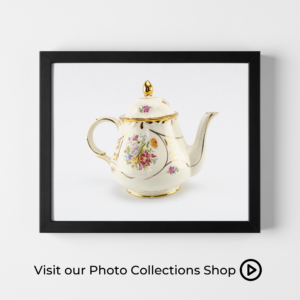I have a confession. Not only are my ancestors nearly all English/Irish, but even before I had my DNA tested, I knew in my heart that I was a confirmed Anglophile. It should come as no surprise then, that the first time I visited London that (a) I felt right at home and (b) I was compelled to buy not one but 2 porcelain teapots.
ANGLOPHILE noun
An·glo·phile | \ ˈaŋ-glə-ˌfī(-ə)l \
: a person who greatly admires or favors England and things English
The British & Their Tea
The British haven’t always made drinking tea a regular part of their day. They weren’t introduced to black tea until the mid-17th century. It was imported from China by the East India Company and the tea’s journey took more than a year. Because of this, it was quite expensive and drinking tea was enjoyed by mostly the wealthy. To further add to the exclusivity, English potters had not yet learned how to make teapots out of porcelain. This was necessary to withstand boiling water. So, the teapots also had to be imported from China.
The British & Their Teapots
Things began looking up for everyday British citizens who longed to drink black tea. Improved shipping methods and ships eventually brought the price of tea down and made it affordable to an even greater portion of British citizens by 1800. Then, by 1815 English potters had perfected hard paste porcelain. This method uses calcined animal bones and produces a body that is finer, whiter, and stronger than soft paste porcelain. You may have heard this called “bone china.” To this day, it continues to be the predominant form of porcelain made by British manufacturers.
A Very Fine Vintage 1970s Porcelain Teapot
 Remember those two teapots I bought on a trip to London in the 1970s? One was for me, the Anglophile, and the other for my mother. Neither one of us ever served tea with these teapots. We just enjoyed them for their decorative beauty. When Mom died, her teapot came to live at my house. I was thrilled to be able to photograph it to be included in our Kitchen Stories Collection of photographs of everyday kitchen objects.
Remember those two teapots I bought on a trip to London in the 1970s? One was for me, the Anglophile, and the other for my mother. Neither one of us ever served tea with these teapots. We just enjoyed them for their decorative beauty. When Mom died, her teapot came to live at my house. I was thrilled to be able to photograph it to be included in our Kitchen Stories Collection of photographs of everyday kitchen objects.
This Chatsworth pattern teapot was made by the Arthur Wood Pottery, operating at that time in Longport, Stoke-on-Trent, England. I was delighted to find out recently that Stoke-on-Trent is still known to be the capital of English fine bone china. In fact, the local football (soccer) club, Stoke City F.C., is lovingly nicknamed “The Potters” to honor the teapot making heritage of their city.
A Bit of English Tea for Your Home
What’s your favorite tea? Mine has always been the Earl Grey blend by Bigelow, an American tea producer. Let me know in the comments what your favorite(s) are. I’d love to know.

Grateful for these sources: http://www.antiques-info.co.uk/new/pdf/Jan12/5.pdf / https://www.chateaurouge.uk/blogs/gourmet-discoveries/a-royal-cuppa-history-of-traditional-english-tea
Want to learn more about English Teapots and the tradition of drinking tea or maybe just want to relax by coloring some teapots?
The Art of Tea: Recipes and Rituals (Victoria)
Color To Relax: Beautiful Teacup Sets & Tea Pots: 30 Hand-Drawn Images, Single Sided



0 Comments